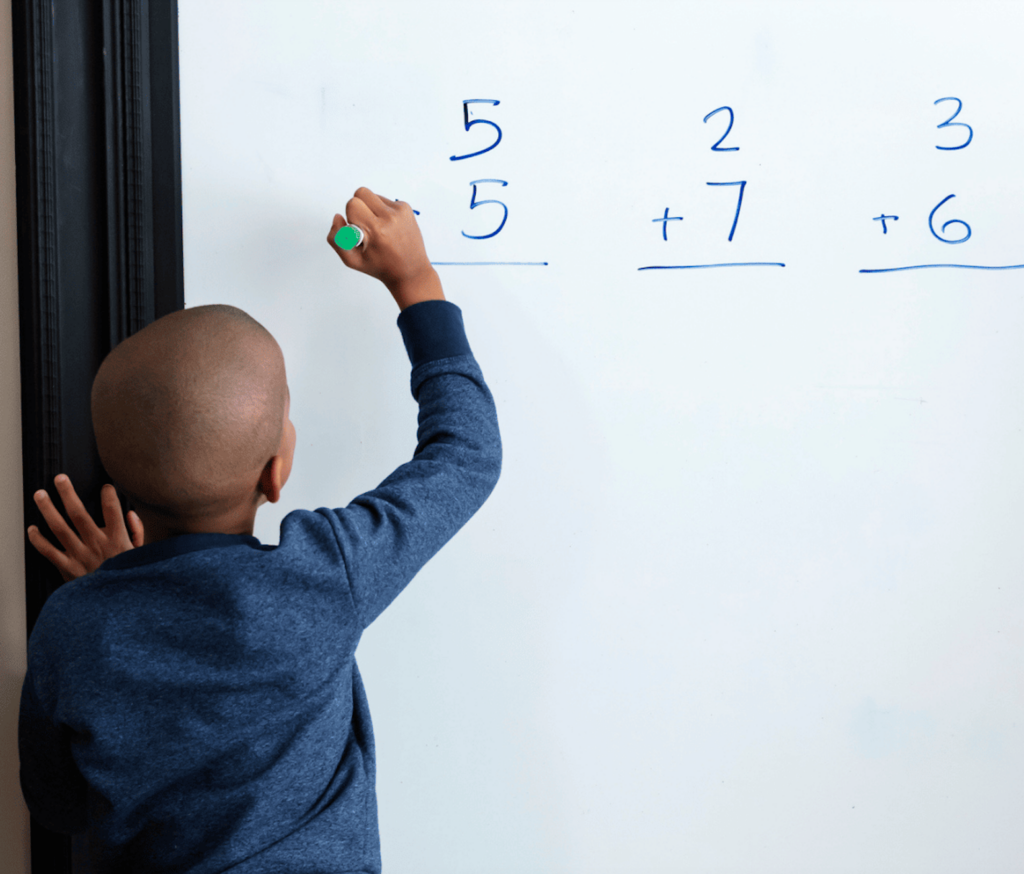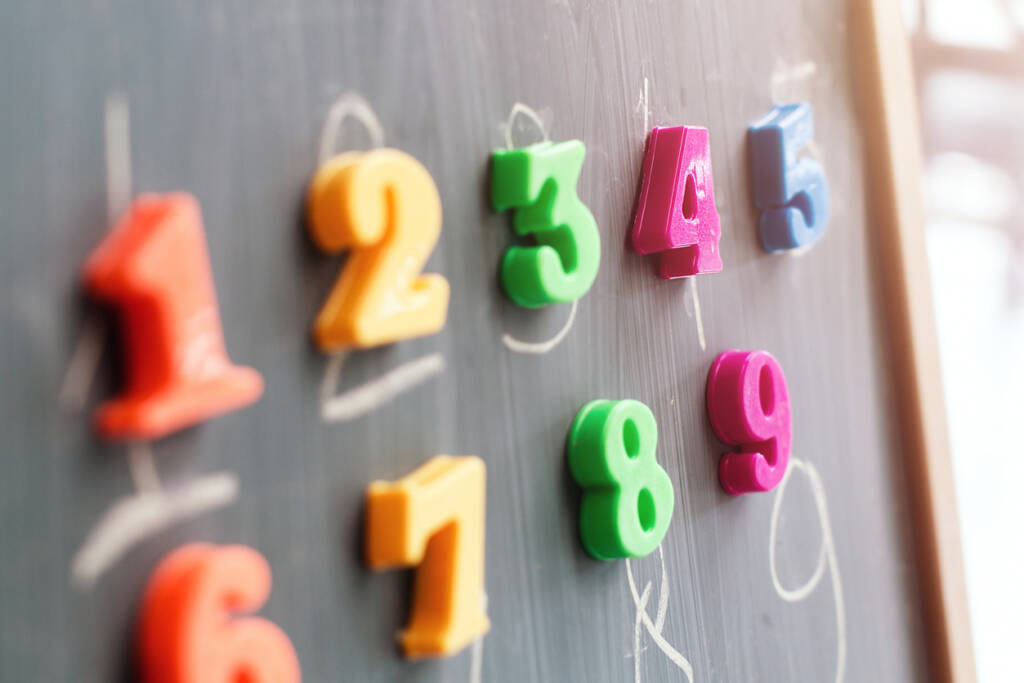
Foundational Math

The K-2 Foundational Math course offers additional support and practice for essential math skills. Weekly meetings with their instructor will provide students with targeted mini-lessons on specific math skills in addition to independent practice on assignments to further develop early math abilities. Students will also have access to online resources with games and activities to build their overall number sense and mathematical skills.
Note: The Foundations of Math course is a valuable resource for students who are struggling with their math skills. It is not a replacement for any grade-level math course. The course is designed to be engaging and fun, and it provides students with the support they need to succeed in math. Completion time and credit will vary based on the competencies taken.
Major Topics and Concepts
The course covers the following topics:
- Counting and Cardinality: Rote counting, reading and writing numbers
- Operations and Algebraic Thinking: Strategies for addition and subtraction, solving word problems
- Numbers in Base 10: Place value, solving equations
- Geometry: Naming and identifying 2D and 3D shapes, describing their features, identifying basic fractions of a whole
- Measurement and Data: Sorting and classifying a set of objects, creating and analyzing graphs and charts, measurement with nonstandard and standard units
Competencies
Beginning Counting and Cardinality
I can identify a given number in a group of numbers 0 - 10. I can name numbers 0 - 10. I can write numbers 0 - 10. I can count from 1 - 100 by 1s. I can count from 10 - 100 by 10s. I can use 1:1 correspondence to count the number of objects in a group. I can use words (greater than, less than, equal to) to compare two groups of objects. I can use symbols (<, >, =) to compare two groups of objects. I can use words (greater than, less than, equal to) to compare two numbers 0 - 10. I can use symbols (<, >, =) to compare two numbers 0 - 10.
Beginning Geometry
I can identify and name a circle, triangle, square, rectangle and hexagon. I can identify a specific shape in a group of shapes of various sizes and colors. I can explain the difference between 2D and 3D shapes. I can differentiate between 2D and 3D shapes. I can draw 2D shapes including a circle, triangle, square, rectangle, and hexagon. I can use materials to build 2D and 3D shapes. I can use smaller shapes to compose a larger shape.
Beginning Measurement and Data
I can describe objects using words like light, heavy, tall, short, big, and small. I can compare objects using words like taller, shorter, heavier and lighter. I can sort a group of objects by color, size and shape. I can count the number of objects in each category. I can put groups of sorted objects in order from smallest to largest.
Beginning Numbers and Base 10
I can identify the number (between 11 - 19) shown using base ten blocks. I can identify the number (between 11 - 19) shown using ten frames. I can explain that the numbers 11 - 19 are made up of a group of 10 plus some more. I can model a number (between 11 - 19) using base ten blocks to show the group of ten plus more. I can model a number (between 11 - 19) using ten frames to show a group of ten plus more.
Beginning Operations
I can add two one-digit numbers together. I can solve addition equations within 10. I can describe what it means to add two numbers together. I can use a strategy (fingers, drawings, objects) to model and solve an addition problem within 10. I can subtract a one-digit number from a number less than or equal to 10. I can solve subtraction equations within 10. I can describe what it means to subtract. I can use a strategy (fingers, drawings, objects) to model and solve a subtraction problem within 10. I can locate and identify numbers in an addition or subtraction word problem. I can use a strategy (fingers, drawings, or manipulatives) to model and solve addition and subtraction word problems. I can locate and identify key words in an addition or subtraction word problem and decide which operation to use. I can identify pairs of numbers that add up to a number less than or equal to 10. I can use number bonds and fact families to decompose numbers up to 10.
Developing Geometry
I can identify specific attributes of a shape (number of sides, vertices, edges, faces, etc.). I can draw a shape based on a description of its attributes. I can identify and name triangles, quadrilaterals, pentagons, hexagons and cubes. I can divide a rectangle into columns and rows to create square units. I can count up the total number of square units in a rectangle. I can divide shapes into two, three and four equal shares. I can identify equal shares as halves, thirds or fourths/quarters of the whole.
Developing Measurement and Data
I can estimate the length of objects using standard units of measure. I can choose appropriate measuring tools to measure objects of different lengths. I can accurately measure objects using standard units of measure. I can compare the length of two objects using standard units of measure. I can tell and write the time displayed on an analog clock to the nearest 5 minutes. I can tell and write the time displayed on a digital clock to the nearest 5 minutes. I can identify if the time is a.m. or p.m. I can identify and name U.S. bills and coins. I can identify the value of U.S. bills and coins. I can write monetary values using the correct symbols. I can solve addition and subtraction word problems involving money. I can create a set of data by measuring various objects to the nearest inch. I can create line plots, pictographs and bar graphs to represent the length data I collected. I can ask and answer questions about the data in my charts and graphs. I can solve comparison problems (sum of, difference between) based on data in charts and graphs.
Developing Number and Operations in Base Ten
I can identify the hundreds, tens, and ones place. I can identify the numeral in the hundreds, tens and ones place of a 3-digit number. I can demonstrate how 100 is the same as ten groups of 10. I can explain how the digit in the hundreds place shows how many groups of 100 there are in a 3-digit number. I can skip count by 5s up to 1000. I can skip count by 10s up to 1000. I can skip count by 100s up to 1000. I can start at a random number and count on up to 1000. I can read and write numbers up to 1000 using numerals and the base ten system. I can read and write numbers up to 1000 using number names (words). I can read and write numbers up to 1000 using expanded form. I can compare two 3-digit numbers using words (greater than, less than and equal to). I can compare two 3-digit numbers using symbols (<, >, =). I can explain how to compare two 3-digit numbers by looking at the digit in the hundreds place first. I can add up to four 2-digit numbers and explain my strategy. I can add and subtract two 3-digit numbers using place value. I can mentally add 10 or 100 to a 3-digit number. I can mentally subtract 10 or 100 from a 3-digit number.
Developing Operations and Algebraic Thinking
I can solve addition equations to 20. I can explain the addition strategy that I use to solve addition equations. I can solve subtraction equations within 20. I can explain the subtraction strategy that I use to solve subtraction equations. I can solve an equation with a missing addend. I can explain the commutative property of addition and show that I understand that if 4+2=6, then 2+4=6. I can explain the associative property of addition when solving an equation with three addends. (If I know that 6+4=10, then 6+4+2=12). I can find numbers and key words within word problems and use pictures, drawings or objects to model and solve addition and subtraction word problems within 20. I can use pictures, drawings and models to solve addition word problems with three addends. I can explain the relationship between addition and subtraction. (If 3+5=8, then 8-3=5).
Emerging Geometry
I can name two dimensional shapes and identify the number of sides and vertices. I can draw two dimensional shapes based on a description of their defining attributes.I can draw shapes such as a circle, triangle, square, rectangle and hexagon. I can build 3D shapes such as a sphere, cylinder, cube, pyramid, cone and rectangular prism. I can use smaller shapes to compose a larger shape. I can identify shapes that are divided into equal parts. I can divide a shape into two equal parts. I can identify the name of one section of a shape divided into two equal parts. I can identify the name of one section of a shape divided into four equal parts.
Emerging Measurement and Data
I can put objects in order by their length. I can measure objects using nonstandard units (smaller object). I can use nonstandard units to compare two objects by length. I can tell time to the nearest hour on an analog clock. I can tell time to the nearest half hour on an analog clock. I can read time to the nearest hour and half hour on a digital clock. I can write the time to the nearest hour and half hour. I can organize and sort a group of objects with up to three categories. I can represent a set of data on a table, chart, pictograph or bar graph. I can ask and answer questions about a set of data based on a pictograph or bar graph.
Emerging Number and Operations in Base Ten
I can count up to 120 by 1s. I can count up to 120 by 10s. I can read two and three digit numbers. I can write two and three digit numbers. I can use base 10 blocks and place value charts to model two digit numbers. I can explain how numbers like 20, 30, and 40 are made up of groups of 10 with no ones. I can compare two digit numbers with words like greater than, less than and equal to. I can compare two digit numbers with symbols (<, >, =). I can explain how to compare two digit numbers by looking at the tens place first. I can identify 10 more and 10 less than a number by memory without using manipulatives or writing numbers down. I can add and subtract groups of ten from a two or three digit number. I can explain my strategy for adding and subtracting groups of 10.
Emerging Operations and Algebraic Thinking
I can draw pictures and use equations to model and solve addition and subtraction word problems within 100. I can solve one and two step addition and subtraction word problems and explain my strategy.I can fluently add numbers within 20 in my head, without having to use my fingers, drawings or manipulatives. I can fluently subtract numbers within 20 in my head, without having to use my fingers, drawings or manipulatives.I can identify if a set of objects is odd or even using a variety of strategies and explain how I know. I can determine the total number of objects in an array (up to 5 x 5) by using repeated addition. I can write a repeated addition equation to represent an array (up to 5 x 5).
